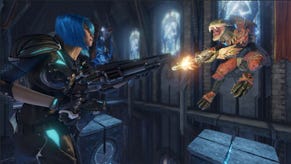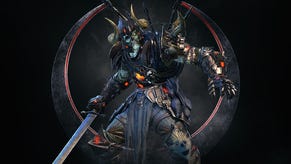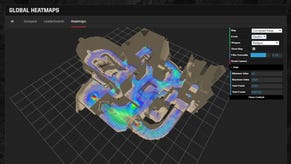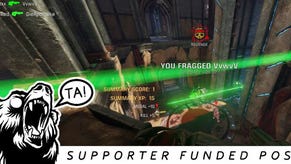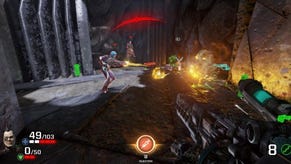Quake Champions Beta: a revitalised classic with some modern ideas
Railly good
Here’s the most important thing you need to know about Quake Champions [official site]: I shot a man to death with a railgun while we were both flying in mid-air. As we passed each other like trains in the night, he exploded into jelly, and a very deep voice bellowed “Impressive!” into my ear. For a split-second I felt like a god, a pure, unstoppable force of destruction. Then a bolt of brilliant green from another player instantly dispelled me of that notion.
It’s moments like these which Quake III: Arena always sought. Not the bit where I died, that happens all the time. It’s that minute instance, that unmeasurable sliver of time where something so remarkable happens that you don’t quite believe it was you who did it. Frankly, I never believed I could do it, which is why despite multiple attempts I never really got on with Quake III, preferring the broader, more varied multiplayer offering of Unreal Tournament back when such distinctions mattered. Quake Champions has me wondering what I missed, which is as high an accolade as I can give this free-to-play multiplayer shooter in its beta form.
Co-developed by id Software and Saber Interactive, Quake Champions is fast and furious, and while I have some qualms about the wrapping of the package, the package itself is builds on the classic Quake multiplayer design smartly and effectively. The core dynamic of shooting another person while moving at speeds normally reserved for vehicles feels very good indeed.
Best described as a modernisation of Quake III’s multiplayer, Quake Champions updates the fast-paced, intense fragging of the 1999 classic with a brand new engine, adds a sprinkling of character-based mechanics into the proceedings, and then surrounds the whole thing with a free-to-play structure. The beta itself comprised three maps and three modes – the traditional deathmatch and team-deathmatch, along with a new mode called Duel.
Going into Quake Champions for the first time, I was a little sceptical. Not only because of my historic allegiance to tribe Unreal, but also due to the flaccid multiplayer offering of last-years DOOM reboot. DOOM may have earned id back their stripes on the singleplayer front, but the multiplayer lacked both style and substance, a drab and dreary affair without a single fresh giblet in its body.
My first couple of games with Quake Champions did little to assuage my scepticism either. Partly because for the first few matches almost everyone was playing as the same character, but mainly because I went through the online equivalent of having my teeth kicked in. Despite fully anticipating Quake Champions to play like a jet-fighter that was late for a particularly important meeting, I wasn’t prepared for the sheer twitchiness of the game. No matter how much I focused, my crosshairs seemed to lag vital milliseconds behind those of my opponents, and even when I did land a few hits, their health-bars seemed infinitely longer than my own. My K/D ratio resembled the Persians at Thermopylae.
As it turns out, this wasn’t mere paranoia. Quake Champions’ main new feature is that its roster of playable characters are more than cosmetic shells for players to inhabit. Each is its own class, weighted differently in terms of health, armour and speed. Nimble yet fragile Champions like Nyx compete alongside slower, tougher individuals like the hulking robot Clutch. What’s more, every Champion has a unique ability they can deploy. I’ll talk more about those shortly.
Realising that we were not all on even footing, I began to put more thought into my approach, adjusting my combat style depending on who I was facing and what weapon I was facing them with, and suddenly Quake Champions clicked. I went from one end of the league table to the other within one or two games, and those moments of bewildered glory began to happen to me.
The core of Quake Champions is supremely well balanced, with each of its redesigned guns offering just the right amount of risk and reward when wielded. Weapons like the machinegun and lightning gun chip constantly away at enemy health, but require sustained focus in order to actually kill. The shotgun and railgun, meanwhile, will put a big dent in your opponent’s health-bar, but have a delay between shots that seems agonisingly long in Quake’s atomic measurement of time. I especially like the new nailgun, which has a spinning barrel that fires a stream of hot nails at a ridiculously fast rate. It acts as a mid-range weapon that I found to be a handy back-up in any situation.
All of this you’ll likely expect from a game based heavily on Quake III, but the point is that Quake Champions delivers it. The maps, too, are smartly designed. Blood Covenant sees players fighting in and around a central plaza that houses the all-important Quad Damage, while Ruins of Sarneth blends twisting subterranean corridors with wide-open spaces that leave unwary players exposed to keen-eyed rail-snipers. Yet while all the maps are elegantly constructed in their 3D geometry, none of them grabbed me in terms of theme or aesthetic. I preferred Sarneth to Blood Covenant because the railgun is easier to access, but that’s about it.
I felt no such ambivalence toward the new character classes, which are a smart way of introducing some extra complexity to Quake III’s formula without ruining the balance or purity of its multiplayer. As I mentioned, alongside their differences in terms of max health and speed, each Champion has access to a power that provides them with a temporary advantage over their opponents.
Visor, for example, can use his ability to highlight opponents through walls. I found this to be particularly useful for getting back into the action quickly, providing the advantage of being slightly prepared for an encounter. Nyx can temporarily turn invisible, while Clutch can activate an energy shield similar to that used by Overwatch's Symmetra. I also highly enjoyed Scalebearer’s Bullrush ability, which lets you charge into opponents, dealing heavy damage and possibly instagibbing them if you’re moving fast enough. It is a bit cheap and possibly overpowered, though, and is one of the few abilities I felt that way toward.
Quake Champions’ character-driven multiplayer is unashamedly inspired by the likes of Team Fortress 2 and Overwatch, although each champion’s unique traits are neither as interesting nor as crucial to the overall design as is the case with those games. This is undoubtedly the right approach. Their differing attributes and abilities are sufficient to spice up Champions’ more traditional multiplayer offering without fundamentally altering the direction of the game.
When it all comes together, Quake Champions is an absolute blast, especially in standard deathmatch. It’s a constant, breathless rush of semi-conscious decisions that have an unseen yet vital impact upon your success or failure. That moment when you drop down an elevator shaft and notice an opponent coming the other way, and launch a rocket to greet them. Or when you weave through a storm of machinegun fire to empty both barrels of your shotgun into your opponent at point blank range. Or when you’re attacked from behind and spin around, launching a rail-shot out of pure reflex, and it connects in a shower of beautiful, rapturous gore. All of this, Quake Champions provides in a way that clearly harks back to Quake III, but feels fresh and new and modern.
All that said, I do have some concerns. I didn’t like the Duel mode at all. This mode pits you against one other player, with each of you selecting three characters from your roster and duking it out over a “best-of-three” series of rounds. Kill your opponent, and they’ll spawn as a new Champion until their roster runs dry and you win the round. It’s simply not as much fun as the chaos and noise of traditional deathmatch or team-deathmatch, although it might be improved with bespoke arenas that don’t feel empty with only two players fighting in them.
Quake Champions also takes too long to get you into a match. I usually had to wait for several minutes before the game’s matchmaking system would find some action to drop me in. This is to be expected in a beta test, but on top of that there are four or five screens between you and the start of play. There’s a map-voting screen, a loading screen, the screen you look at while waiting for the other players to load, a needless fly-through of the map you’re playing on, and finally a screen that displays the assembled fighters. It’s all so baggy and unnecessary, the antithesis of the snappy, immediate feel of the game itself.
My biggest worry, however, is to do with the free-to-play model, which locks away all the Champions bar one unless you “rent” them for 24 hours using points earned in battle, or purchase them outright with real-life money. This is a bad idea for several reasons. It means that early fights with other low-ranking players are populated entirely with the starting character, Ranger, which hardly shows off Quake Champions at its best. But more importantly, it’s just a bit mean. The game should be about learning each of these Champions and picking your favourites, not fighting just to unlock its main new feature. Other F2P games have shown that players will happily spend money on cosmetic items in games they like, and I think locking out the Champions in this manner is more likely to put off potential players than encourage them to join in.
Still, I can’t deny that Quake Champions got under my skin in a way that I never expected it to. It balances tradition with innovation just right, and I reckon that provided Bethesda don’t get too greedy with the free-to-play model, it’ll be popular both with Quake veterans hungry for some frenetic old-school action, and neophytes like me who either have never played Quake before or never particularly understood it. It may not be as characterful as Overwatch or as innovative as Titanfall 2, but Quake Champions has got something else – pedigree and blistering pace.










